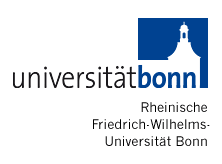Project Coordinator
Professor Dr. Cyrill Stachniss
University of Bonn
Institute of Geodesy and Geoinformation
Department of Photogrammetry
Nussallee 15
53115 Bonn, Germany
From 11/2011 to 12/2014, the research unit was coordinated by Professor Dr. Wolfgang Förstner
Deputy Coordinator
Professor Dr. Sven Behnke
University of Bonn
Institute of Computer Science
Computer Science Department VI
Friedrich-Ebert-Allee 144
53113 Bonn
Project Description
The goal of the project is the development and testing of procedures and algorithms for the fast three-dimensional identification and mensuration of inaccessible objects on the basis of a semantically specified user inquiry. The sensor platform is a lightweight autonomously flying drone. It uses the visual information from cameras for navigation, obstacle detection, exploration and object acquisition.
Our group will develop the appropiate models, methods and algorithms and evaluates them prototypically in suburban areas, using building structures, vegetation and stationary traffic detection as examples. Key elements of the develped methods are the problem-specific generation of models of complex spatiotemporal patterns and the explicit treatment of the uncertainty of data and models.
One can summarize the technology necessary for the solution of these tasks with the term "Mapping on Demand". "Mapping on Demand" covers all processes, algorithms and tools for the acquisition of new data and the processing and interpretation of existing data. The goal is to derive a visual model of the spatial phenomena and draw user specified space-related conclusions, which should be in time from the point of view of the user. The development of this technology is necessary for two reasons:
- Due to the online three-dimensional reconstruction of the environment the aircraft can react autonomously to obstacles and field-of-view obstacles and bypass them. So a very high completeness of the reconstruction can be reached.
- Since the visual information is interpreted immediately, relevant information for the user about the object is already present during the flight or at least at the end of the flight. This information can be used for subsequent decisions.
The user of such an acquisition and exploration system is relieved concerning navigation, and gets an application-specific spatiotemporal interpreted representation of the object. The goal of the project therefore can be clearly distinguished from classical procedures of simultaneous localization and mapping (SLAM), as it concerns simultaneous navigation and interpretation. There is a very wide variety of applications so that the project members concentrate first on simple search, identification and reconstruction tasks in suburban areas. However the realization takes place in a context of science, which can use each kind of provisional technical results immediately, for example geosciences and agricultural sciences.

